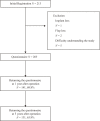Long-Term Patient Satisfaction and Quality of Life Following Breast Reconstruction Using the BREAST-Q: A Prospective Cohort Study
- PMID: 35692774
- PMCID: PMC9178786
- DOI: 10.3389/fonc.2022.815498
Long-Term Patient Satisfaction and Quality of Life Following Breast Reconstruction Using the BREAST-Q: A Prospective Cohort Study
Abstract
Background: Breast reconstruction is a promising surgical technique to improve health-related quality of life (HRQoL) in patients with breast cancer. However, the long-term risk factors associated with HRQoL after breast surgery are still unclear. Our aim was to evaluate breast satisfaction and HRQoL following breast reconstruction to identify clinical factors associated with each domain of BREAST-Q in the long-term.
Methods: Patient-reported BREAST-Q outcomes were analyzed 1 and 5 years after breast reconstruction in a single-blinded, prospective study. Multiple regression analysis was performed to identify the risk and protective factors associated with BREAST-Q scores. These scores at 1 and 5 years were also compared across three types of operation: mastectomy only, tissue expander/implant (TE/Imp), and a deep inferior epigastric perforator (DIEP) flap.
Results: Surveys were completed by 141 subjects after 1 year and 131 subjects after 5 years. Compared to mastectomy only, breast reconstruction was significantly associated with greater "Satisfaction with breasts" (TE/Imp, p < 0.001; DIEP, p < 0.001) and "Psychosocial well-being" (TE/Imp, p < 0.001; DIEP, p < 0.001), higher body mass index (BMI) resulted in lower "Satisfaction with breasts" (p = 0.004), and a history of psychiatric or neurological medication was significantly associated with "Physical well-being" at 1-year postoperatively (p = 0.02). At 5 years, reconstructive procedures were significantly positively associated with greater "Satisfaction with breasts" (TE/Imp, p < 0.001; DIEP, p < 0.001) and "Psychosocial well-being" (TE/Imp, p = 0.03; DIEP, p < 0.001), and a bilateral procedure was a significant risk factor for lower "Psychosocial well-being" (p = 0.02).
Conclusions: The results of this study show that breast reconstruction improves "Satisfaction with Breasts" and "Psychosocial well-being" compared to mastectomy. Among all three types of operation, DIEP gave the best scores at 5 years postoperatively. Thus, autologous reconstruction is recommended for promotion of long-term HRQoL after breast surgery.
Keywords: BREAST-Q; DIEP; breast implant; breast reconstruction; health-related quality of life; tissue expander.
Copyright © 2022 Shiraishi, Sowa, Tsuge, Kodama, Inafuku and Morimoto.
Conflict of interest statement
The authors declare that the research was conducted in the absence of any commercial or financial relationships that could be construed as a potential conflict of interest.
Figures



References
LinkOut - more resources
Full Text Sources

